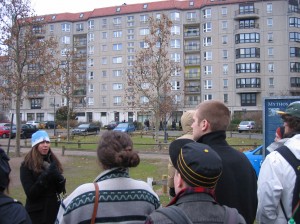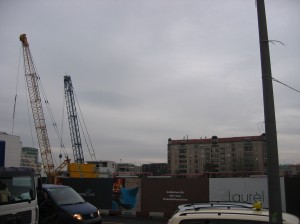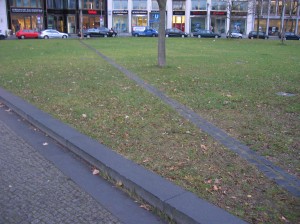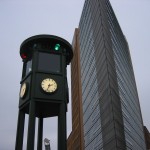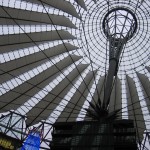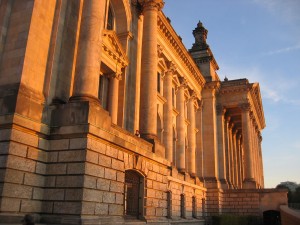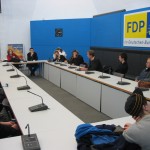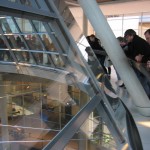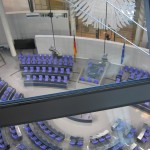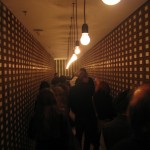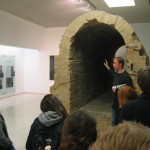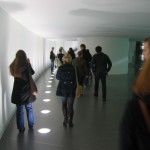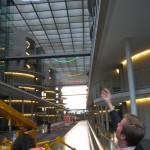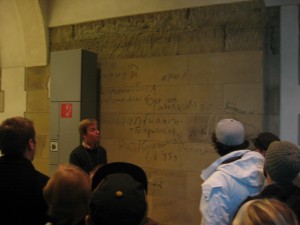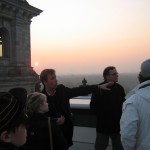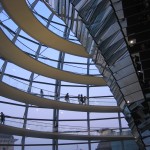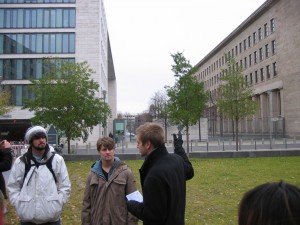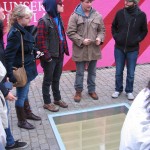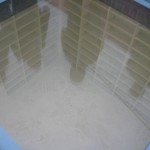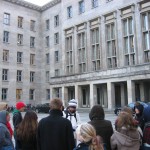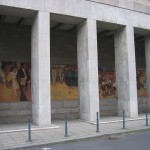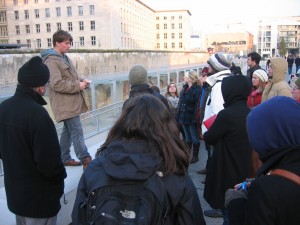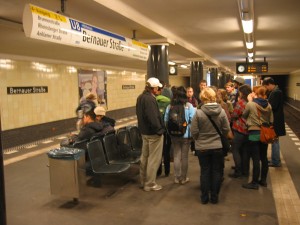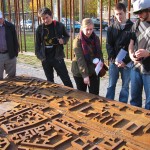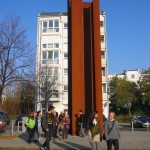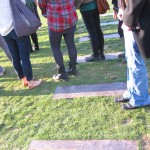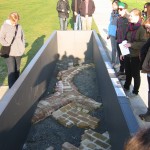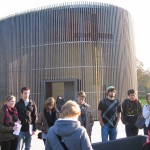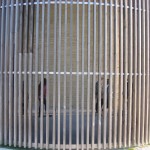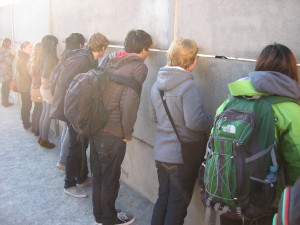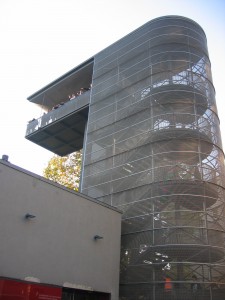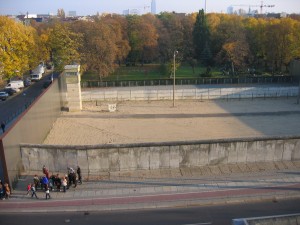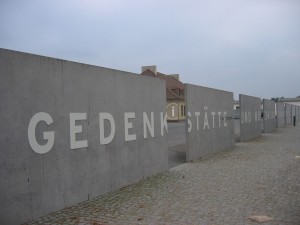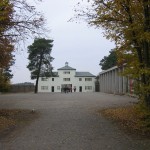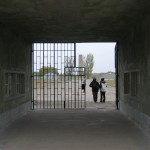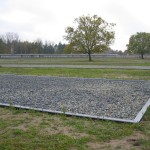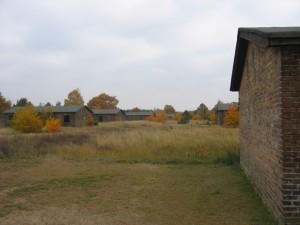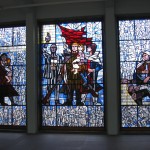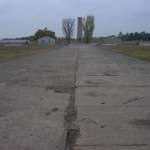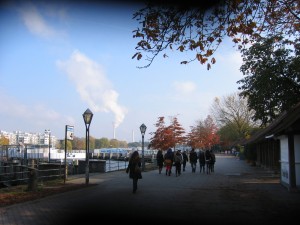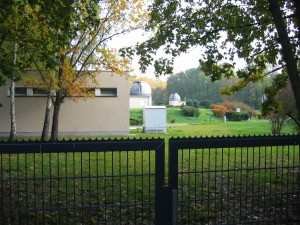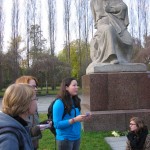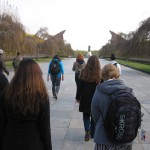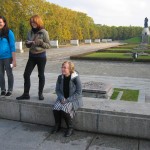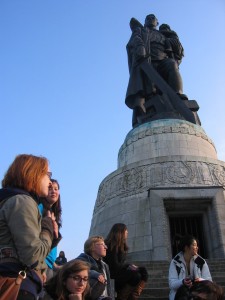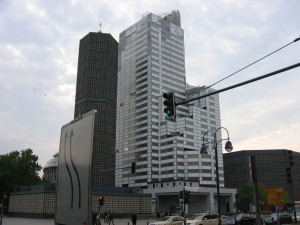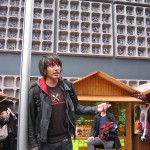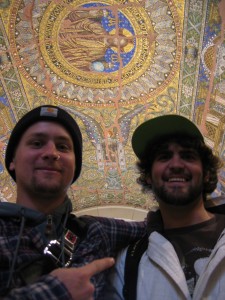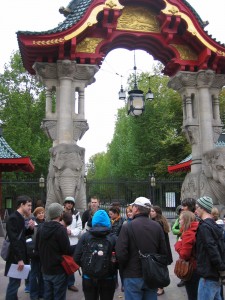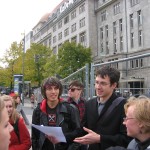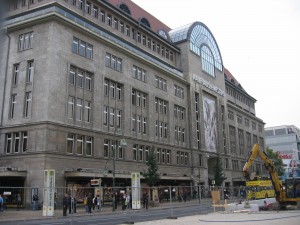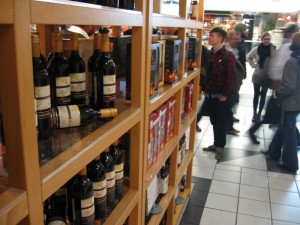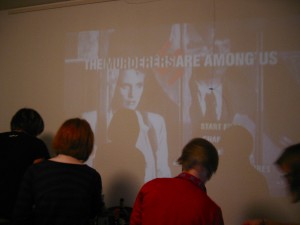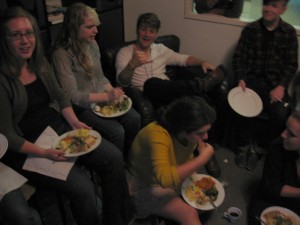A tour of Potsdamer Platz with Natalie & Ryna
Our final student-led walk took place this week, with a tour of Potsdamer Platz and its surroundings by Natalie and Ryna.
We started out at the former site of Hitler’s bunker – now hidden under a parking lot and GDR-era apartment buildings.
Our next stop was a huge construction site on Leipziger Platz, just half a block from Postdamer Platz. This plot was once home to Wertheim’s department store, headed by the pioneering and gifted businessman Georg Wertheim. Because he was Jewish, however, he was forced to leave the country in 1937, leaving his wife Ursula in charge of the company, which eventually folded and was re-established under different ownership after the war.
Now a new shopping center is being constructed on the site. Though it’s not owned by the Wertheim family, the idea is to refer to the strong commercial history of the area.
Also on Leipziger Platz, we viewed the brick strip that marks where the Berlin Wall once ran. It’s amazing to think that this whole area was a divided, empty wasteland just twenty years ago!
Potsdamer Platz is also strongly associated with certain technological breakthroughs – it became home to one of Europe’s very first traffic lights in 1924, and it is now also a center of the film industry in Berlin. The Sony Center (right) embodies this with its hi-tech roof design.
Moving from a booming commercial center in the twenties to bombed-out no-man’s-land during the mid-twentieth century, then back to thriving retail hub today, Potsdamer Platz is emblematic of the many recent and violent transformations of Berlin. It’s a fitting end to our student tours!
A visit to the Reichstag
Our activities this week included a tour of the Reichstag (the German parliament building).
Our guide was Ulli Finkenbusch, who works for the Free Democratic Party (FDP). After an introductory discussion about some important political issues facing Germany, we took a tour of the building, beginning with the mezzanine level.
On the lower level of the main parliament building, we viewed an artwork by Christian Bolstanski (left), consisting of metal boxes with the names of all the German Parliament members since 1919. We also saw the remains of the tunnel through which the arsonist who set fire to the Reichstag in 1993 is supposed to have entered building.
We then traversed the underground walkway connecting the Reichstag with the parliament meeting rooms and offices in the Paul-Löbe-Haus.
On our way back through the Reichstag, we glimpsed graffiti left by Soviet soldiers in 1945, which has been preserved as part of the integral history of the building.
Our final stop was on the roof, where Ulli pointed out several of the city sights that are visible from there, and we enjoyed a beautiful sunset!
A tour of Nazi architecture in Mitte with Max, Klayton and Nick
Our theme for this week is the rebuilding of Berlin after the fall of the wall, and one of the things that architects, planners and politicians had to contend with was the history of totalitarianism that was still inscribed on the landscape. To deepen our understanding of this issue, our students Nick, Max and Klayton took us on a tour of sites in Mitte with Nazi history today.
The first stop on the tour was the Foreign Ministry, housed in the former Nazi Reichsbank (the browner building to the right). The first freely elected East German parliament also met here for a time in 1989-90, as they negotiated their integration with the West. In the early 1990s, a “Critical Reconstructionist” architect designed an addition (left). This is an approach, used throughout the center of the new Berlin, that seeks to integrate historical building traditions with modern design.
Next, we visited the memorial to the Nazi book burnings on Bebelplatz, right in front of the Humboldt University buildings.
The current Finance Ministry is housed in another interesting building with a layered history. Built to house the Nazi Air Ministry, it then became home to the GDR’s Council of Ministers after 1949. A socialist realist mural (right) was added at this time. The site is also known for its association with the workers’ uprising in 1953, and there is a memorial to this event on the grounds today.
Our last stop on the tour was the Topography of Terror, a site that contains the excavated remains of the Gestapo headquarters, as well as a museum dedicated to the history of Nazi-sponsored persecution. The Berlin Wall also ran along the edge of the site, as you can see above.
We’ll continue our exploration of Berlin’s responses to its own layered past next week, when we’ll be focusing on issues of memorialization.
A Tour of the Bernauer Strasse Wall Memorial with Libby, Roxana and Dominic
This week our students Libby, Roxana and Dominic took us on a tour of the Berlin Wall Memorial on Bernauer Strasse. We started the tour in the subway station, which during East German times had been a “ghost station” — because it lay in the East, it was a place that West German subways passed through but did not stop. Sometimes armed guards could be glimpsed in the darkened stations, but otherwise they were silent. Now they’ve been restored, and the U8 train stops at all the stations between Moritzplatz and Voltastrasse once more!
Emerging at street level, we entered the memorial site, which stretches for several blocks. The park encompasses what was formerly the ‘death strip’ – the space in between the two halves of the wall that divided East from West. Our tour guides directed us toward the many markers of structures that once existed on the site, including escape tunnels (right).
One of the most remarkable structures to have inhabited the death strip was an entire church, paradoxically named the Church of Reconciliation. It was demolished in the early 1980s by the East German government, but the foundations remain (left) and are now incorporated as relics in the park. A chapel has been built on the site to commemorate the many who died trying to escape over the wall.
Another portion of the park contains a reconstruction of the wall as it existed during East German times. This consists of a wall on the east side, then a large expanse of sand and barbed wire, and then finally another concrete wall on the west side. From the viewing tower that is part of the memorial museum (below), you can look down into this reconstructed portion.
Perhaps what is most amazing about this site is that it’s one of the only places in Berlin that you can tell there was ever a wall at all! The rest of the city has been so thoroughly sutured back together that you really have to hunt for the traces. This park preserves the memory of the terror that the wall once represented for Berlin’s citizens.
KZ Sachsenhausen: four layers of memory
Our visit to Buchenwald last weekend left us all with much to think about concerning the troublesome history of the Holocaust and the aftermath of WWII. This past Friday, we visited another concentration camp site, this time much nearer to Berlin. As opposed to Buchenwald, which is somewhat removed from the town of Weimar, Sachsenhausen is set essentially within the town of Oranienburg. The students were shocked to see how close the camp was to the surrounding houses: it reveals much about the attitude of many Germans toward the existence of these sites during the Nazi era.
The exhibitions and interpretive materials on the site (which is still in the process of being remodeled) seek to reveal four major eras in the camp’s existence. The first is the building and use of the camp by the Nazis, beginning in 1936. Though many Jews were imprisoned here, it was better known as a camp for political prisoners, especially Communists. It was also a prominent training site for the SS, as well as a “show” camp for Hitler and his officials. Though it wasn’t a death camp, tens of thousands of prisoners died here as a result of starvation, disease, abuse, and torture, as well as medical experiments.
After the war, the Soviets used Sachsenhausen as a “special camp” where they held various German prisoners to await trial. (Above: extra housing outside the camp walls which was used during this time.) Several thousand people died during this stage of the camp’s existence – mostly of starvation, disease and exposure. It’s difficult to know what to do with the memory of these deaths, as many of the prisoners were either Nazis themselves, or had been willing participants in the culture of the regime. Still, the evidence of human suffering here is also staggering.
After the Soviets abandoned the camp, the GDR government refurbished it (as they did Buchenwald) as a memorial site. Here at Sachsenhausen, this included a large memorial structure (where soldiers were regularly inducted into the army), as well as a museum that emphasized the suffering of the Communist prisoners held here by the Nazis. For East Germany, the identity of the Communists as victims of the fascist regime was a central part of the national narrative, so sites like these became points for the public expression of collective persecution at the hands of the Nazis – even if very few GDR citizens had actually been Communists prior to 1945. On the other hand, the memory of the Soviet camp was completely suppressed under the East Germans, so that families who had lost loved ones here during the post-war period were unable to speak about their own suffering until after 1989.
With the fall of the wall, the camp became a flashpoint for conflicting narratives and memories: how can both victims of the Nazis and Nazis or collaborators themselves be remembered and mourned on the same site? This is a question that haunts many spaces in Berlin, not only Sachsenhausen. The current design of the site attempts to deal with this through a “decentralized” approach, using the various structures to house extensive exhibitions of archival material. Still, we’re left wondering: how do we decide who has the right to be remembered, and how?
There are many more buildings on the site, but I couldn’t bring myself to photograph them. Sites of terrible suffering and unspeakable crimes, I think they are best left to be pondered in the abstract. If you’re interested, however, you can read more about the site here.
Treptower Park with Anna, Mariah and Janet
The student tour this week brought us to Treptower Park, home to …
… houseboats (one of three colonies in Berlin) …
An observatory built for a world’s expo in the park around the turn of the century, and later supposedly used by Einstein …
… and an absolutely massive Soviet World War II memorial and cemetery. Since the park lies in what was formerly East Berlin, it was a natural choice for the Soviets to honor 7,000 of their men who died here. The site is now under the official protection and care of the German government, thanks to a line in the treaty signed by the Soviets in 1989.
The main attraction is a 38-foot statue of a Soviet solder saving a child, posed over a broken swastika. Though it’s a bit over the top, one can’t help but think about the staggering number of men buried here. It’s another sobering facet of Berlin’s complex, and often tragic, history.
Ku’damm, Zoo and KaDeWe with Robert, Dan and Niguel
Our students Robert, Dan and Niguel took us on a great tour of the Ku’Damm/Zoostation area of Berlin this Tuesday. We began just off the Ku’Damm at the Gedächtniskirche – the ruin of a church built by Kaiser Wilhelm II and bombed in 1943. The ruin has become one of the symbols of Berlin, but you can’t see it at the moment – it’s under that ugly white scaffolding you can see in the picture above. Surrounding the ruin are a chapel and belltower designed by the German modernist Egon Eiermann in the 1950s.
We headed into the ground floor of the ruin first. The ceiling still displays some beautiful Byzantine-style mosaics, duly appreciated by our class …
We then headed next door to the Eiermann-designed chapel. Though the newer buildings aren’t much to look at from the exterior (Berliners have nicknamed them the “lipstick and powder box”), the chapel is pretty stunning on the interior. We caught the organist practicing, which added to the atmosphere.
Our next stop was the zoo, where our guides not only acquainted us with the incredible diversity of its inhabitants – the most in the world! – but related the heartbreaking story of Knut, the baby polar bear born in the zoo in 2006. Knut was a media favorite (with good reason – he really was incredibly adorable!), but unfortunately he died earlier this year.
The mood picked back up as we moved to our last stop, the famous Kaufhaus des Westens, or KaDeWe. It’s the biggest department store in continental Europe, with a history that spans over 100 years.
The top floor of the store is known for its incredible selection of foods, both local and imported. And what should we find as we come up the escalators but a little taste of home – Columbia Crest, on sale. It seems we’re not the only Washington imports to Berlin!
Movie Night: The Murderers Are Among Us
We had our first movie night this week, and as our theme for seminar was Trümmer – rubble – it seemed appropriate to screen The Murderers Are Among Us. Shot in 1945-46 on location in war-torn Berlin, it’s the story of love, loss and revenge, and a meditation on the ravages of WWII. Distributed by the Russians, the ending of the film (the main character was originally supposed to kill his former commanding officer) had to be changed because it was thought that it might instigate revenge killings.
Our evening began with an amazing potluck, courtesy of the students, including curry, crepes and other delicacies prepared in the kitchens of their Arwobau apartments. We then continued with a cozy screening in the living room of Rachel, Annie and Melissa’s apartment. (We have a teeny tiny projector and speakers provided by CHID — they work wonderfully!)
All agreed that the movie was pertinent, moving and beautiful, even if we did think that the couple fell in love a little too fast for our modern sensibilities … a highly recommended film about post-war Germany.
tags
the author
I'm a doctoral student at CUNY Graduate Center. I'm thrilled to be teaching the CHID Berlin program with Prof. John Toews! You can contact me at naraelle [at] gmail.com, or find out more about me at www.naraelle.net.
Blogroll
- Annie Holden's blog
- Cassie Hoeprich's blog
- Dominic Barrera's blog
- Janet Williams's blog
- Mariah Alderete's blog
- Melissa Au's blog
- Robert Hampton's blog
- UW Students Study Abroad Our students Natalie and Cassie are contributing to the official IPE student blog this fall!



